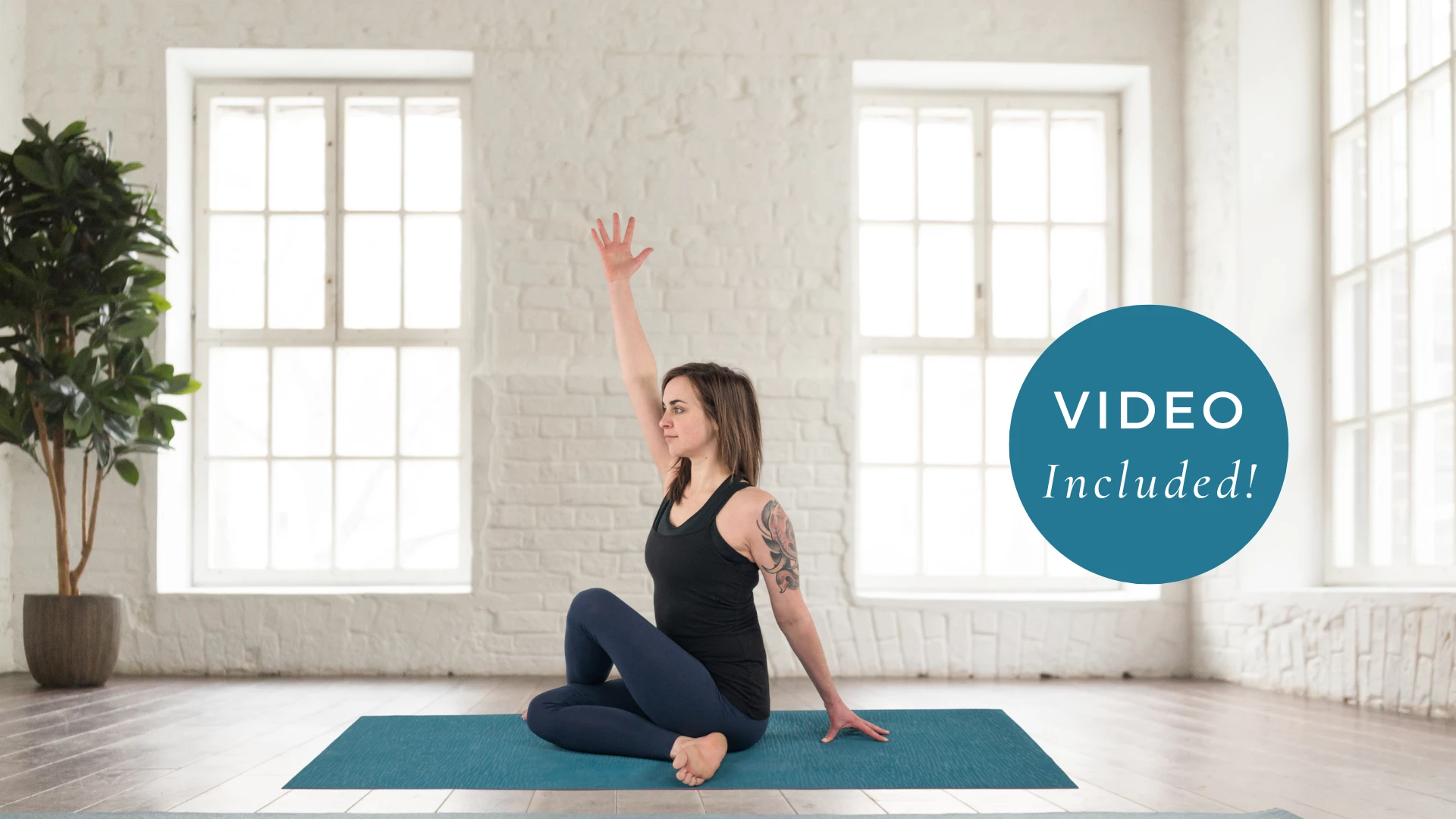Practice Yoga Twists at the Wall to Increase Spinal Mobility

Article At A Glance
Joseph Pilates said, “You are only as young as your spine is flexible.” This article includes practice tips and a tutorial video designed to help increase spinal mobility with yoga seated twists practiced at the wall. Go slow, practice mindfully, and enjoy!
Twisting is a fundamental aspect of many yoga asanas, a position we often practice in our everyday lives. Yoga twists are a functional movement we practice consistently without ever noticing (think reaching to the back seat of your car to grab your grocery bags or simply just looking back over your shoulder).
In yoga, we use spinal mobility and rotation a lot. In poses from Parivrtta Trikonasana (Revolved Triangle Pose) (below) to Ardha Matsyendrasana (Half Lord of the Fishes) (under next heading), we emphasize spinal mobility and rotation often. And for good reason!

Rotation is a primary movement of the spine and one that is needed for optimal spinal mobility and health. But the spine is a complex and intricate structure. Spinal rotation isn’t necessarily easy for all parts of the spine due to bony structure limitations.
However, it is healthy to move our bodies in their natural ranges of motion, so spinal rotation throughout the entire spinal column can help to keep your spine nourished, hydrated, and healthy. Using a wall to help the rotation in yoga twists may be helpful for your practice.
Spinal Mobility in Rotation Isn’t Equal Everywhere
All parts of the back allow for different degrees of spinal mobility in other planes of movement. The most extensive range of motion in the spine occurs at the cervical (neck) and lumbar (lower back) vertebrae because these are the most mobile structures.
However, in spinal rotation, the thoracic spine (middle and upper back) allows for much movement (second only to the highly mobile cervical spine).
In rotation, the average ranges of motion in the different parts of the spine are:
- Cervical Spine: 60 to 80 degrees
- Thoracic Spine: 35 to 50 degrees
- Lumbar Spine: 5 to 20 degrees
These are only averages. This means that some people may have more range, and some may have less. Practice mindfully.
In rotation, the lumbar spine allows for the least amount of rotation. But that doesn’t mean we can’t include the lumbar spine in our spinal yoga twists. We can use a wall for support to help reach this “stickier” area of rotation.
Here’s How to Safely Practice Yoga Twists at a Wall to Help Increase Spinal Mobility
For this, you will need two blocks and some open wall space. Practice mindfully, slowing, and avoiding over-twisting, especially if twisting is counter-indicated for you.
- Place your yoga mat against a wall with the long edge of your mat touching the wall.
- Put your two blocks side by side in the center of your mat to create a little “seat” to sit on top of.
- Sionof your blocks with the wall on your right side.
- Stretch your leg in front of you and root down into your sit bones. Sit toward the bottom edge of your blocks so that you can tilt your pelvis forward ever so slightly to create a neutral inward curvature in your lumbar spine.
- Bend your right knee, place your foot on the floor, and draw your heel in closely toward your pelvis.
- Root down into your right foot and your sitting bones to lift and lengthen your whole back body. Stretch the crown of your head toward the sky.
- Activate your left leg by pressing your heel into the floor, flexing your ankle, reaching out through the ball of your foot, and spreading your toes.
- With an inhale, grow taller through your spine, place your right hand on the wall next to you, and wrap your left elbow around your right knee.
- As you exhale, slowly spiral your torso toward the wall. Strive to start rotating your lumbar spine first and then move the rotation up your back body into your thoracic spine and, finally, your cervical spine.
- With every breath in, grow a little bit taller in your spine. With every breath out, use that newfound space to spiral a little further in your torso to face more toward the wall.
- If it feels appropriate, you can readjust your hands (perhaps placing them both on the wall or perhaps walking them farther across the wall as you rotate your spine farther with each breath). Be mindful not to force anything in the twist by leveraging the wall or your arm strength. Instead, let the rotation happen from the muscles of your back and core and from the mobility available to your bone structure. Remember that different parts of the spine allow for varying levels of mobility, so don’t push anything beyond your limits.
- Hold for a few long, deep breaths before slowly unwinding your twist and returning to a neutral spine. Hold neutral for a few deep breaths before switching sides.
Variations with the Ardha Matsyendrasana Shape
- If you’d like, you can play with the positioning of your legs by coming into a more traditional Ardha Matsyendrasana shape. To do so, cross your right foot over your left knee and bend your left knee to slide your left heel toward your outer right hip.
- If appropriate, you may also wish to hook your left elbow around the outside of your right thigh (in either leg variation). Be mindful not to use brute force to work your way into the twist, but instead, gradually rotate using your breath and core strength to facilitate the movements.
- If twists bother your sacroiliac joints (SI joints), you may wish to twist your pelvis along with your spine in the twist. In this case, slide your left heel down your mat so your pelvis rotates before you even begin twisting your spine. You may wish to take this variation occasionally to switch up your twists even if you don’t get SI joint irritation.
- If it feels appropriate for you, you may wish to remove the blocks from under your seat and twist with your sit bones on another prop or the floor.
Explore Yoga Twist Variations for Mobility in Your Spine
There are so many fun and variable ways to play with revolved asanas, and working with a wall is just one of the many ways you can work with your yoga twists to help increase spinal mobility.
As always, go slowly, follow your breath, and move safely and with intention as you play with this fun variation of a seated twist. Give it a try and see how it feels in your body. You might make twisting at the wall a new part of your everyday practice!
Also, read...
4 Ways to Practice Locust Pose
5 Keys to Healthy Neck Alignment in Cobra Pose (Bhujangasana)
Uttanasana: Expand Your Breath
Related courses
Breath as Medicine: Yogic Breathing for Vital Aging
Yoga and Myofascial Release: Releasing Chronic Tension with the Bodymind Ballwork Method

Leah Sugerman is a yoga teacher, writer, and passionate world traveler. An eternally grateful student, she has trained in countless schools and traditions of the practice. She teaches a fusion of the styles she has studied with a strong emphasis on breath, alignment, and anatomical integrity. Leah teaches workshops, retreats, and trainings, both internationally and online. For more information, visit www.leahsugerman.com.





